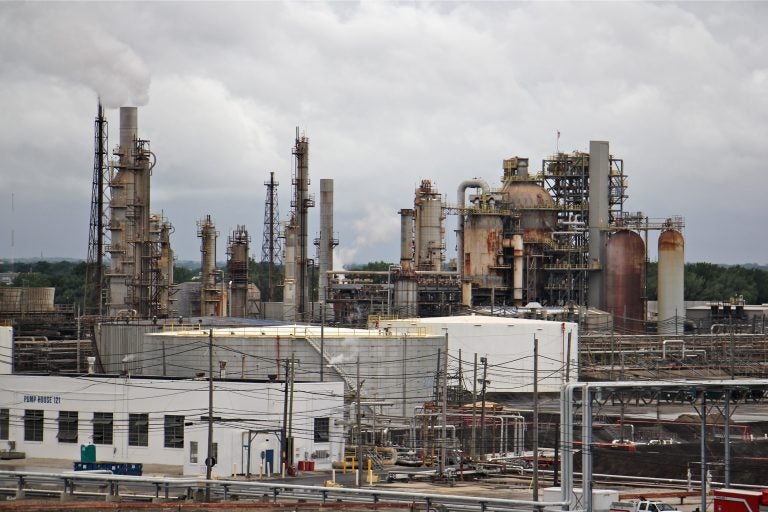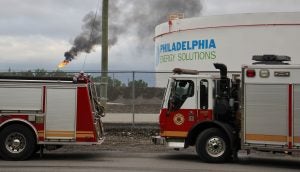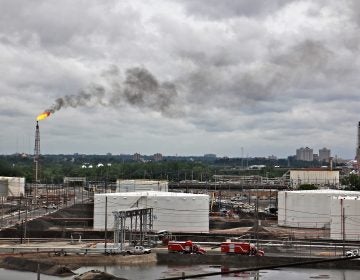Possible future uses for PES refinery call into question cleanup plans there
Current remediation being done by former owner Sunoco may no longer make sense if the potential purpose of the site changes, some experts say.

Philadelphia Energy Solutions refinery in South Philadelphia. (Emma Lee/WHYY)
Updated 2:58 p.m.
A working group convened by Philadelphia officials will focus on the future use of the Philadelphia Energy Solutions refinery and its 1,300-acre footprint in South Philadelphia now that the company has announced that damage from the June 21 explosion and fire would make it impossible to keep the plant open.
More than 1,000 people will be out of work because of the refinery’s closure. In a statement Wednesday, U.S. Sen. Bob Casey (D-Pa.) said he has received a commitment from Philadelphia Energy Solutions that it will pay workers affected by the shutdown through Aug. 25, rather than the earlier announced July 12. Casey said he made a direct appeal to PES’s chief executive Mark Smith on behalf of the workers.
Philadelphia Managing Director Brian Abernathy said the city wants to see the PES refinery become a job creator that is both safe for the environment and the surrounding community.
“But we have to have a realistic conversation. We’re not going to have a playground on this site. We’re not going to turn this into green space or parks and recreation space,” Abernathy said Tuesday on WHYY’s Radio Times.
“This is an industrial site that has over a hundred years of pollutants. If it becomes reused, it’s likely to be another industrial site,” Abernathy said.
Renewable energy is one potential reuse for the site, he said, but it would not generate as many permanent jobs as other uses would.
Different companies have operated refineries at the site since 1866, with very little regulation until the 1970s. Both the soil and the groundwater there are heavily contaminated with petroleum hydrocarbons that have negative effects on human health, including benzene, lead, toluene, ethylbenzene, xylene, and other toxic compounds. Some contaminants have migrated off the site, potentially affecting a drinking-water aquifer used by New Jersey.
“You can’t redevelop the site to the point that it could be clean enough to put people, and especially children,” Peter DeCarlo, associate professor of environmental engineering and chemistry at Drexel University, said during the same Radio Times segment. “The dangers for chronic disease or cancer would just be astronomical. It wouldn’t be worth the risk.”
The task of cleaning up that historic contamination falls to Sunoco (now Energy Transfer), the refinery’s former owner. Evergreen Resources Group, LLC is managing the remediation on behalf of the company. In 2012, when Delaware’s Carlyle Group entered a joint venture with Sunoco to form Philadelphia Energy Solutions, the purchase agreement established that any new contamination generated by the refinery after the deal was finalized in 2013 would be PES’s responsibility.
Sunoco has been working on the remediation of the site, monitored by the Pennsylvania Department of Environmental Protection, since 2003. The company identified contaminants and made cleanup plans for the entire facility, divided into 10 geographic areas of interest.
But Christina Simeone, a senior fellow at the University of Pennsylvania’s Kleinman Center for Energy Policy who has authored multiple reports on the refinery, said Sunoco’s remediation plans may no longer make sense if the future use of the site changes. Even though company CEO Mark Smith said PES will position the refinery complex for a sale and restart, analysts told StateImpact Pennsylvania that finding a buyer will be almost impossible.
“Sunoco has been seeking site-specific industrial [pollution concentration] standards based on risk assessment that assumes the site would continue to be an operating refinery,” Simeone said in a separate interview Tuesday. “If the site’s no longer an operating refinery, it might call into question the appropriateness of some of these standards.”
Simeone said those standards are less stringent than statewide health standards.
“For example, they have a lead-in-soil standard that’s twice the health-based industrial standard for the state of Pennsylvania,” Simeone said.
Philadelphia’s Abernathy said the city has those same concerns.
“That’s a fair question: Is the environmental remediation appropriate, and what environmental remediation needs to happen,” he said, adding that the environmental impact of the site is “something that the city is very, very much focused on.”
Simeone said that even though several parts of Sunoco’s cleanup plan have already been accepted by the DEP — eight of the 10 areas of interest, including the one where the explosion occurred — the legality of those approvals has also been questioned. She says the City of Philadelphia, neighbors and other stakeholders have not been given the opportunity to be involved in the remediation planning, which is legally required by the DEP.
“Sunoco’s failure to engage with the community on remediation efforts elevates a disturbing trend in our city and across the nation,” Clear Air Council executive director Joseph Otis Minott wrote in PlanPhilly on June 20, in a commentary that followed a June 10 fire at the refinery. “Communities of color and low-income residents are forced to bear a higher burden of dangerous air pollution and environmental hazards.”
Abernathy said that Sunoco was warned, and that the city required the company to include public input in the future.
Simeone said the legal issue could create “a bit of a perfect storm” that could allow regulators to revise the cleanup standards.
“Sunoco could say: ‘Well, we have already gone through the process and it’s already done so you can’t change it.’ If they were following the law, they would probably have a pretty strong argument,” she said. “But they were not following the law.”
DEP spokeswoman Virginia Cain said the agency is in discussions with the city, Sunoco and other stakeholders to determine what steps need to be taken to correct the omissions in public involvement.
Energy Transfer declined to comment for this article. Evergreen Resources, the subsidiary set up by Sunoco to handle legacy environmental issues at the site, recently created a website making all the remediation documents available to the public and establishing a comment period for the next Pennsylvania Act 2 reports.
According to a report by Simeone, as of December 2017 the estimated cost for remediation of the site, to the standards approved by DEP, was $17.4 million.
PES will have to respond to any environmental impact caused after 2013, including the damage caused by the fire. Virginia Cain, a spokeswoman for the DEP, said the agency has not been able to evaluate conditions at the site yet. But experts contacted for this story ventured that most of the pollution went into the air, not into soil or water.
“At this time, DEP cannot speculate on a cost estimate for the remaining work,” Cain said in an email.
Still, the fact that two companies are involved in cleaning up the site could create problems, said Bill Muno, a private consultant and former director for the Environmental Protection Agency’s Superfund program in Chicago. He’s currently involved in an arbitration on a chemical plant with the same issue.
“The problem that we got into in this case that I’m currently involved in is that it’s very hard to separate what’s old and what’s new,” Muno said. “Maybe the sale’s agreement between Sunoco and PES made that very clear, but often that can be a very, very sticky issue.”
Muno said the Superfund program created by the federal government to fund the cleanup of contaminated sites could act as a safety net if PES filed for bankruptcy.
Simeone said that wouldn’t be fair.
“There is a responsible party here. In no way should the taxpayer have to pay, which is what Superfund is — taxpayers end up paying for contamination at a site where the entity went bankrupt and can’t pay or isn’t around any more,” she said.
“Just because PES might go bankrupt, there is still a very financially healthy Sunoco who maintains responsibility to clean up that site,” she noted. “And behind Sunoco is Energy Transfer Partners. So the pockets are very deep.”
WHYY is your source for fact-based, in-depth journalism and information. As a nonprofit organization, we rely on financial support from readers like you. Please give today.






